begin quote from:
Colt AR-15 - Wikipedia
https://en.wikipedia.org/wiki/Colt_AR-15
The Colt AR-15 is a lightweight, 5.56×45mm, magazine-fed, gas-operated semi-
Top stories
Colt AR-15
| Colt AR-15 | |
|---|---|
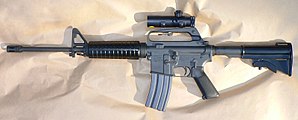
The Colt AR-15
|
|
| Type | Semi-automatic rifle |
| Place of origin | United States |
| Service history | |
| In service | 1964–present |
| Production history | |
| Designer | Eugene Stoner, Jim Sullivan, Bob Fremont |
| Manufacturer | Colt |
| Variants | see List of Colt AR-15 variants |
| Specifications | |
| Barrel length |
|
| Cartridge | |
| Action | Direct impingement |
| Effective firing range | ~550 metres (600 yd) |
| Feed system | Issued with 5-, 10-, 20- & 30-round STANAG magazines |
| Sights |
|
Contents
History
1973 Colt
AR-15 SP1 rifle with "slab side" lower receiver (lacking raised boss
around magazine release button) and original Colt 20-round box magazine
A Colt AR-15 on display at the National Firearms Museum. This example is
fitted with an early waffle-patterned 20-round magazine.
Operating mechanism
Diagram of an M16 rifle, firing
Gas is tapped from the barrel as the bullet moves past a gas port located above the rifle's front sight base. The gas expands into the port and down a gas tube, located above the barrel that runs from the front sight base into the AR-15's upper receiver. Here, the gas tube protrudes into a "gas key" (bolt carrier key), which accepts the gas and funnels it into the bolt carrier.
At this point, the bolt is locked into the barrel extension by locking lugs, so the expanding gas forces the bolt carrier backward a short distance. As the bolt carrier moves toward the butt of the gun, the bolt cam pin, riding in a slot on the bolt carrier, forces the bolt to rotate and thus unlocks it from the barrel extension. Once the bolt is fully unlocked it begins its rearward movement along with the bolt carrier. The bolt's rearward motion extracts the empty cartridge case from the chamber. As soon as the neck of the case clears the barrel extension, the bolt's spring-loaded ejector forces it out the ejection port in the side of the upper receiver.
Behind the bolt carrier is a plastic or metal buffer, which rests in line with a return spring. The buffer spring begins to push the bolt carrier and bolt back toward the chamber once it is compressed sufficiently. A groove machined into the upper receiver guides the bolt cam pin and prevents it and the bolt from rotating into a closed position. The bolt's locking lugs push a fresh round from the magazine as the bolt moves forward. The round is guided by feed ramps into the chamber. As the bolt's locking lugs move past the barrel extension, the cam pin twists into a pocket milled into the upper receiver. This twisting action follows the groove cut into the carrier and forces the bolt to twist and "lock" into the barrel extension.
Features
AR-15A2 with the upper and lower receiver opened at the front hinge.
The AR-15A2 most distinctive ergonomic feature is the carrying handle and rear sight assembly on top of the receiver.
Bullet exiting an A2-style flash suppressor
Two STANAG-compliant magazines: A 20-round Colt-manufactured magazine,
and a 30-round Heckler & Koch "High Reliability" magazine.
Upper receivers
The upper receiver incorporates the fore stock, the charging handle, the forward assist, the gas operating system, the barrel, the bolt and bolt carrier assembly. AR-15s employ a modular design. Thus one upper receiver can quickly and easily be substituted for another. Upper receivers are available with barrels of different weights, lengths, calibers, and rail systems with various sights and accessories. The standard AR-15 rifle uses a 20" barrel. Although, both shorter 16" carbine barrels and longer 24" target barrels are also available.Early models had barrels with a 1:12 rate of twist for the original 223 Remington, 55 grain (3.6 g) bullets. Current models have barrels with a 1:9 or 1:7 twist rate for the 5.56×45mm NATO, 62 grain (4 g) bullets.
Lower receivers
The lower receiver incorporates the magazine well, the pistol grip and the buttstock. The lower receiver also contains the trigger, disconnector, hammer and fire selector (collectively known as the fire control group). Full-sized rifles use a fixed buttstock, while carbines generally use an adjustable telescoping buttstock.The early commercial SP-1 AR-15s used a pair of .250" diameter receiver push pins, identical to those found on the military rifles. In 1966 the company replaced the front pin with a paired nut and screw hinge using a .315" diameter pin to prevent shooters from being able to change receivers with military rifles or competitor rifles without the use of an adapter. They resumed production with the smaller and standardized .250" pin in the mid-1990s.[3]
Sights
The AR-15's most distinctive ergonomic feature is the carrying handle and rear sight assembly on top of the receiver. This is a by-product of the original ArmaLite design, where the carry handle served to protect the charging handle.[4] As the line of sight is 2.5 in (63.5 mm) over the bore, the AR-15 has an inherent parallax problem. At closer ranges (typically inside 15–20 meters), the shooter must compensate by aiming high to place shots where desired. The standard AR-15 rifle has a 500 mm (19.75 inches) sight radius.[5] The AR-15 uses an L-type flip, aperture rear sight and it is adjustable with two settings, 0 to 300 meters and 300 to 400 meters.[6] The front sight is a post adjustable for elevation. The rear sight can be adjusted for windage. The sights can be adjusted with a bullet tip or pointed tool. The AR-15 can also mount a scope on the carrying handle. With the advent of the AR-15A2, a new fully adjustable rear sight was added, allowing the rear sight to be dialed in for specific range settings between 300 and 800 meters and to allow windage adjustments without the need of a tool or cartridge.[7] Current versions such as AR-15A4 use Picatinny rails, which allows the use of various scopes and sighting devices.Muzzle devices
Colt AR-15 rifles most often have a barrel threaded in 1⁄2"-28 threads to incorporate the use of a muzzle device such as a flash suppressor, sound suppressor or muzzle brake. The initial design, the "duckbill," had three tines or prongs and was prone to breakage and getting entangled in vegetation. The design was later changed to close the end to avoid this problem. Eventually, on the A2 version of the rifle, the bottom port was closed to reduce muzzle climb and prevent dust from rising when the rifle was fired in the prone position.[8] For these reasons, the US military declared this muzzle device a compensator, but it is more commonly known as the "GI", "A2", or "Birdcage" muzzle device.[9] The standard AR15 muzzle device conforms to the STANAG dimensional requirements for firing 22mm rifle grenades.Magazines
The Colt AR-15 uses 20- or 30-round staggered-column detachable box magazines. Low-capacity 5- or 10-round magazines are also available to comply with legal restrictions, for hunting, for benchrest shooting or where a larger magazine can be inconvenient.Marketplace
After Colt's patents expired in 1977,[10] an active marketplace emerged, as other manufactures began to copy the Colt AR-15 rifle's design. However, the term "AR-15" is a Colt registered trademark and Colt only uses the term to refer to its line of semi-automatic rifles. Therefore, other manufacturers began to market their generic AR-15s under separate designations, although these are all frequently referred to as AR-15s.[11]AR-15 type rifles are available in a wide range of configurations and calibers from a large number of manufacturers. These configurations range from standard full-sizes rifles with 20-inch barrels, to short carbine-length models with 16-inch barrels, adjustable length stocks and optical sights, to long range target models with 24-inch barrels, bipods and high-powered scopes. These calibers include the 5.56×45mm NATO, 5.7×28mm, 6.8mm Remington SPC, .300 Blackout, 9×19mm Parabellum and .458 SOCOM to name a few.[12][13]
There is also a vast assortment of aftermarket parts and accessories available for the AR-15 rifle. Including: Upper & Lower Receivers, Barrels, Magazines, Bolt Carrier Groups, Charging Handles, Furniture & Stock Kits, Picatinny Rails, Muzzle Devices, Trigger Groups, Bi-Pods, Lasers, Tactical Lights, Carry Handles, Sights, Scopes and Optics, to name a few.
Gallery
See also
- ArmaLite AR-15
- CAR-15
- Colt Automatic Rifle (CAR)
- List of Colt AR-15 variants
- Modern sporting rifle
- ArmaLite
- Assault weapon
- Bushmaster XM-15
- SR-47
- Table of handgun and rifle cartridges
- Port Arthur massacre (Australia)
References
- Evolution of an AR | Gear | Guns & Ammo Archived September 15, 2011, at the Wayback Machine.. Archives.gunsandammo.com (August 29, 2011). Retrieved on 2011-09-27.
Bibliography
- Stevens, R. Blake and Edward C. Ezell. The Black Rifle M16 Retrospective. Enhanced second printing. Cobourg, Ontario, Canada: Collector Grade Publications Incorporated, 1994. ISBN 0-88935-115-5.
- Bartocci, Christopher R. Black Rifle II The M16 Into the 21st Century. Cobourg, Ontario, Canada: Collector Grade Publications Incorporated, 2004. ISBN 0-88935-348-4.
| Wikimedia Commons has media related to AR-15. |
 Participate in an international science photo competition!
Participate in an international science photo competition!



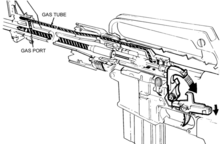
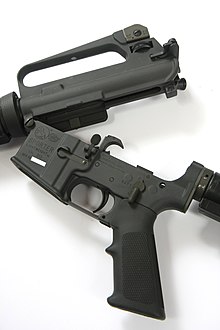
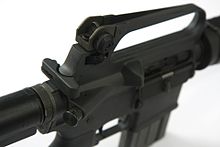

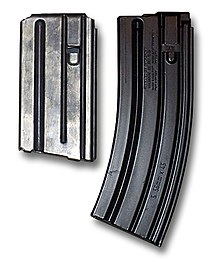












No comments:
Post a Comment